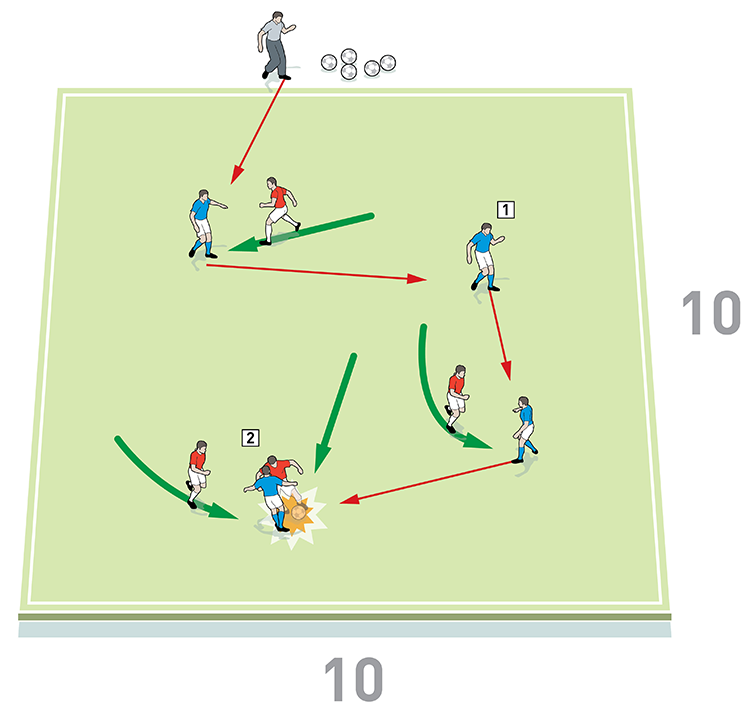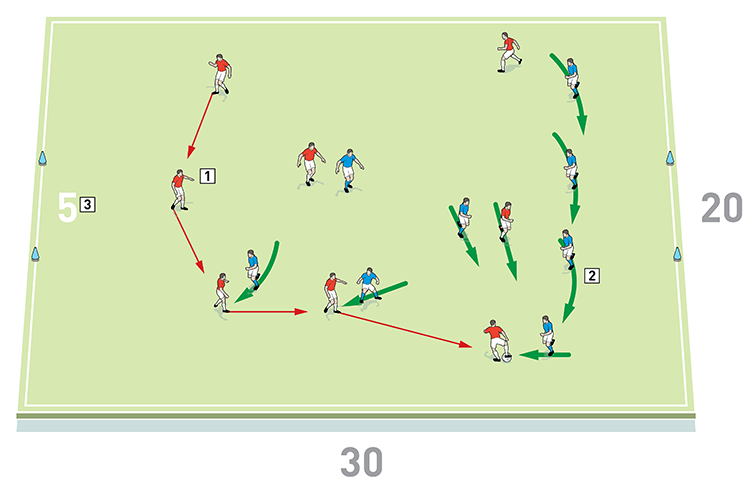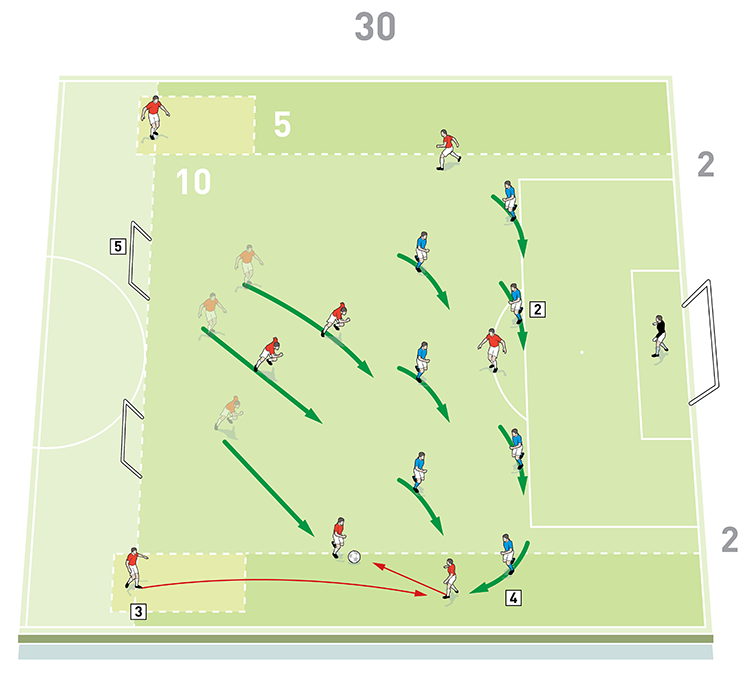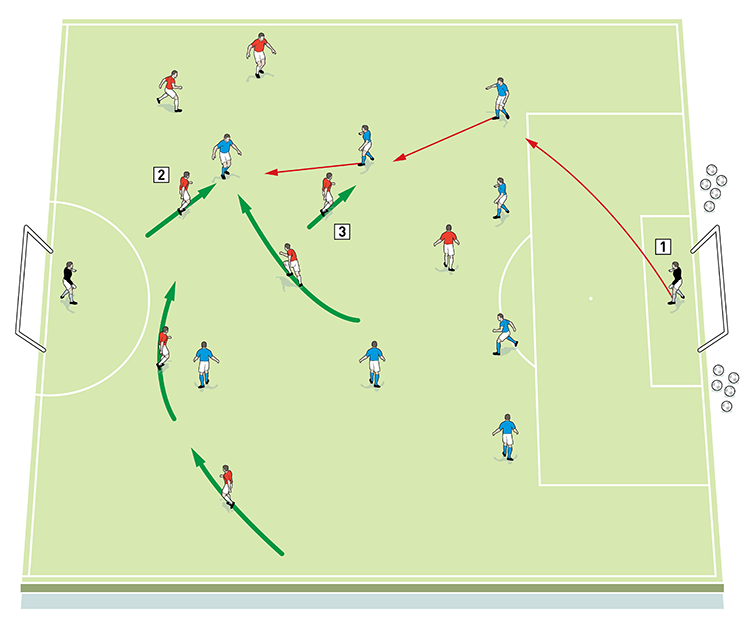




OUR BEST EVER OFFER - SAVE £100/$100
JOIN THE WORLD'S LEADING PROFESSIONAL DEVELOPMENT PROGRAMME
- 12 months membership of Elite Soccer
- Print copy of Elite Player & Coach Development
- Print copy of The Training Ground
Compact defending
| Area | Up to full pitch |
| Equipment | Balls, bibs, cones,2 mini goals, 2 full size goals |
| No. of Players | 16 players + 2 goalkeepers |
| Session Time | Pressing 4v4: 10mins, Pressing 8v8: 10mins, Compact defending: 15mins, 9v9game: 20mins |
This session is all about learning how to defend in our own half, while tactically forcing the opposition into wide areas and encouraging crosses, which is an opposition weakness. It also encourages compactness and teaches players how and when to press.
This was a session that I used regularly when I coached in the Bangladesh Premier League because my players lacked coordinated technical detail, especially on their individual roles and how their own roles would fit into the larger tactical picture.
What do I get the players to do?
Pressing 4v4
We set up in an area of 10x10 yards. We’re using eight outfield players split into two teams of four. We play a 4v4 game with the team in possession trying to keep the ball while passing and receiving. Passes around the inside edge of the area help to keep possession, while an attacking pass across the middle of the area may be more dangerous but would score a point for the possession team if received successfully.
The other team presses hard and tries to win the ball, as shown [1]. We encourage teams to press in intense 10 second bursts, to work on their fitness and synchronisation. If they win the ball they transition quickly into the new passing team.
1

2. The reds press to win the ball in intense 10 second bursts. If they win possession, they quickly transition into the passing team
We would usually have two group playing simultaneously.
Pressing 8v8
We set up in an area of 30x20 yards with five-yard cone gates at either end. We’re using 16 outfield players split into two teams of eight. We play a directional 8v8 game, using the same passing and receiving principles as in the previous practice, but this time the possession team scores by passing through the gate at the end they are attacking.
The pressing team should be encouraged to drop, keep compact and press intensely, both as individuals and as units, to force the possession team wide, as shown [2].
2

2. The blue pressing team should drop, keep compact and press intensely, as individuals and as units, to force the possession team wide
3. If the blues win the ball, they transition into the attacking team and must create an opportunity to pass through the cone gate at the end they are attacking
Compact defending
We set up on just under half a pitch with a goal and a goalkeeper in their usual positions at one end.
A goal line is marked out at the other end, with two mini goals and two wide boxes of 10x5 yards positioned on it, as shown [3].
3

2. The blue team has seven outfield players and a goalkeeper. They line up with a keeper, four defenders and three midfielders. They defend the main goal
3. A red full back starts play with a pass out of the wide box. He must pass to one of the red attackers in the midfield area
4. The blue defending team press as a unit and try to keep play in the wide channels where the reds can only cross or are forced back into the wide boxes
5. If the blue defending team wins possession, they can counter-attack either of the mini goals
We’re using 15 outfield players and one goalkeeper. One team is made up of eight outfield players (here, the reds) and they line up in a 2-3-3 formation attacking the main goal, with one full back in each of the wide boxes. The other team lines up with a goalkeeper, four defenders and three midfielders (here, the blues).
A full back for the red attacking team starts play with a pass out of the wide box. He must pass to one of the red forwards in the midfield area. The blue defending team should press as a unit and force play into the wide channels – the reds should be made to cross or are pushed back into the wide boxes.
The blue midfielders should support their defenders by tracking runners and screening the ball in the dangerous central areas, while the blue centre backs should remain in the central areas if possible, picking up threats and defending crosses.
If the blue defending team wins possession of the ball, they can attack either of the mini goals at the other end.
9v9 game
We set up on half a pitch with a goal at each end. We’re using 16 outfield players and two goalkeepers, split into two teams of nine. We play a 9v9 game, with play always restarting quickly with a pass out from the goalkeeper of the blues, who are the attacking team, as shown [4].
4

2. The reds must defend compactly as a unit and try to force the blues wide
3. The defending midfielders should screen for attacking passes and track runners
We coach the reds, who are the defending team. They should be expected to use all the defending principles that were practised in the previous activities.
How would you put this into a game situation?
To finish the session, we progress the previous 9v9 activity into an 11v11 game played on a full pitch [not shown]. This could be with or without restrictions depending on the progress that the players have made.
For example, if it is felt there is a need to impose restrictions on the players, an assistant coach can feed balls into the attacking team to quickly restart with a full back in the middle third and the full back can play fast into the striker’s feet, meaning the defending team has to get its ‘block’ in place quickly.
It’s important that any session of this nature is played out in an 11v11 game, so we can assess what real learning has taken place.
If it seems that the players have failed to take the coaching points onboard, then we can readjust the original activities to take account of any holes in the players’ learning.
What are the key things to look out for?
Technically, we’re looking at the players’ body posture without the ball, their distances from the ball, and whether they are observing the ball. Their eyes should be focused both on the ball and the opposition.
Then we will look at the first press and whether the pressing player is timing the press correctly, as we want to see if he can affect the ball. We also want to see if the players around him are aware of their compactness relative to the area of the pitch.
Tactically, we want to see that all players are dropping to defend and whether the shape is what we are looking for in any given situation, including outlets if the ball is won.
We will look at forcing play wide to encourage the opposition to cross and making sure we are compact at the edge of the box to stop pull backs. We also want to make sure the central midfielders track any runners in pockets, especially between the full backs and the centre backs when the full backs are pressing.
What are the typical mistakes players might make and how do I avoid them?
Pressing too early or too late will massively affect the ability of the team to defend successfully, so it is vital that players recognise the triggers that tell them when to press. Use coaching breaks to talk players through the relevant triggers.
Related Files
Editor's Picks
Attacking transitions
Deep runs in the final third
Using the goalkeeper in build-up play
Intensive boxes drill with goals
Penetrating the final third
Creating and finishing
My philosophy
Pressing initiation
Compact team movement
Coaches' Testimonials

Alan Pardew

Arsène Wenger

Brendan Rodgers

Carlos Carvalhal

José Mourinho

Jürgen Klopp

Pep Guardiola

Roy Hodgson

Sir Alex Ferguson

Steven Gerrard
Coaches' Testimonials

Gerald Kearney, Downtown Las Vegas Soccer Club

Paul Butler, Florida, USA

Rick Shields, Springboro, USA

Tony Green, Pierrefonds Titans, Quebec, Canada
Join the world's leading coaches and managers and discover for yourself one of the best kept secrets in coaching. No other training tool on the planet is written or read by the calibre of names you’ll find in Elite Soccer.
In a recent survey 92% of subscribers said Elite Soccer makes them more confident, 89% said it makes them a more effective coach and 91% said it makes them more inspired.
Get Monthly Inspiration
All the latest techniques and approaches
Since 2010 Elite Soccer has given subscribers exclusive insight into the training ground practices of the world’s best coaches. Published in partnership with the League Managers Association we have unparalleled access to the leading lights in the English leagues, as well as a host of international managers.
Elite Soccer exclusively features sessions written by the coaches themselves. There are no observed sessions and no sessions “in the style of”, just first-hand advice delivered direct to you from the coach.







